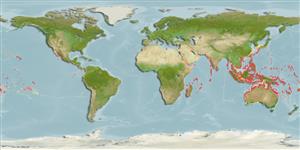Common names from other countries
Classification / Names / Names
ماع يماسا | فدارتم | Catalog of Fishes (gen., sp.) | ITIS | CoL | WoRMS
Environment: milieu / climate zone / depth range / distribution range
يسانش موب
; قمع تارييغت 2 - 30 m (Ref. 349). Tropical
Indo-Pacific.
Length at first maturity / Size / Weight / نس
Maturity: Lm ? range ? - ? cm Max length : 36.0 cm ShH يسنج صاوخ نودب / رن سنج; (Ref. 349); common length : 22.0 cm SHL يسنج صاوخ نودب / رن سنج; (Ref. 349)
Frequently collected in the area for food and for the shell which is traditionally used as a decorative item in many parts, or as container for liquids by the natives of the South Seas (Ref. 349). Live in colonies. During periods of activity, lift their shell straight up to move forward, then drop it down. Often partially buried below the surface of sand when inactive or during feeding. Preys on the crown-of-thorns Acanthaster planci, which is recently responsible for the devastation of many coral reefs (Ref. 349).
Life cycle and mating behavior
غولب | لثم دیلوت | یزیر مخت | اه مخت | Fecundity | )ورال ( دازوت
Members of the order Neotaenioglossa are mostly gonochoric and broadcast spawners. Life cycle: Embryos develop into planktonic trocophore larvae and later into juvenile veligers before becoming fully grown adults.
یلصا ذخآم
عجارم | هدننك گنهامه | ناراكمه
Poutiers, J.M. 1998. (Ref. 349)
NCUI زمرق تسرهف رد تيعضو (Ref. 130435)
ستياس رظن زا تيعضو (Ref. 108899)
Not Evaluated
Not Evaluated
یناسنا هدافتسا
تاليش – يريگ يهام: يراجت
| FishSource | Sea Around Us
اهرازبا
يتنرتنيا عبانم
Estimates based on models
Preferred temperature
(Ref.
115969): 24.6 - 29.3, mean 28.4 (based on 3285 cells).
یريذپ بيسآ
Low to moderate vulnerability (26 of 100).
تميق هقبط
Unknown.
